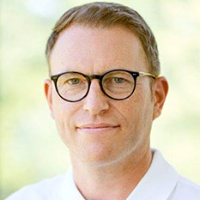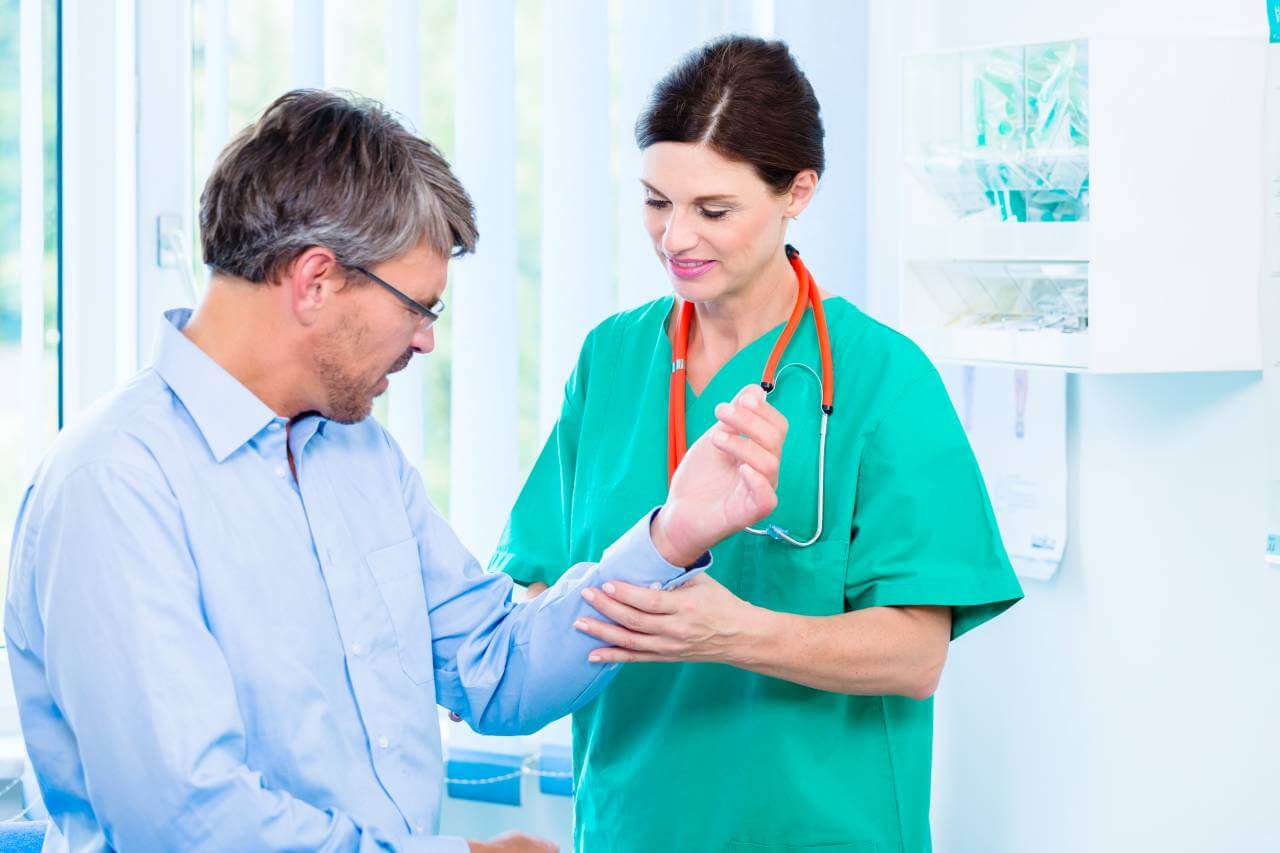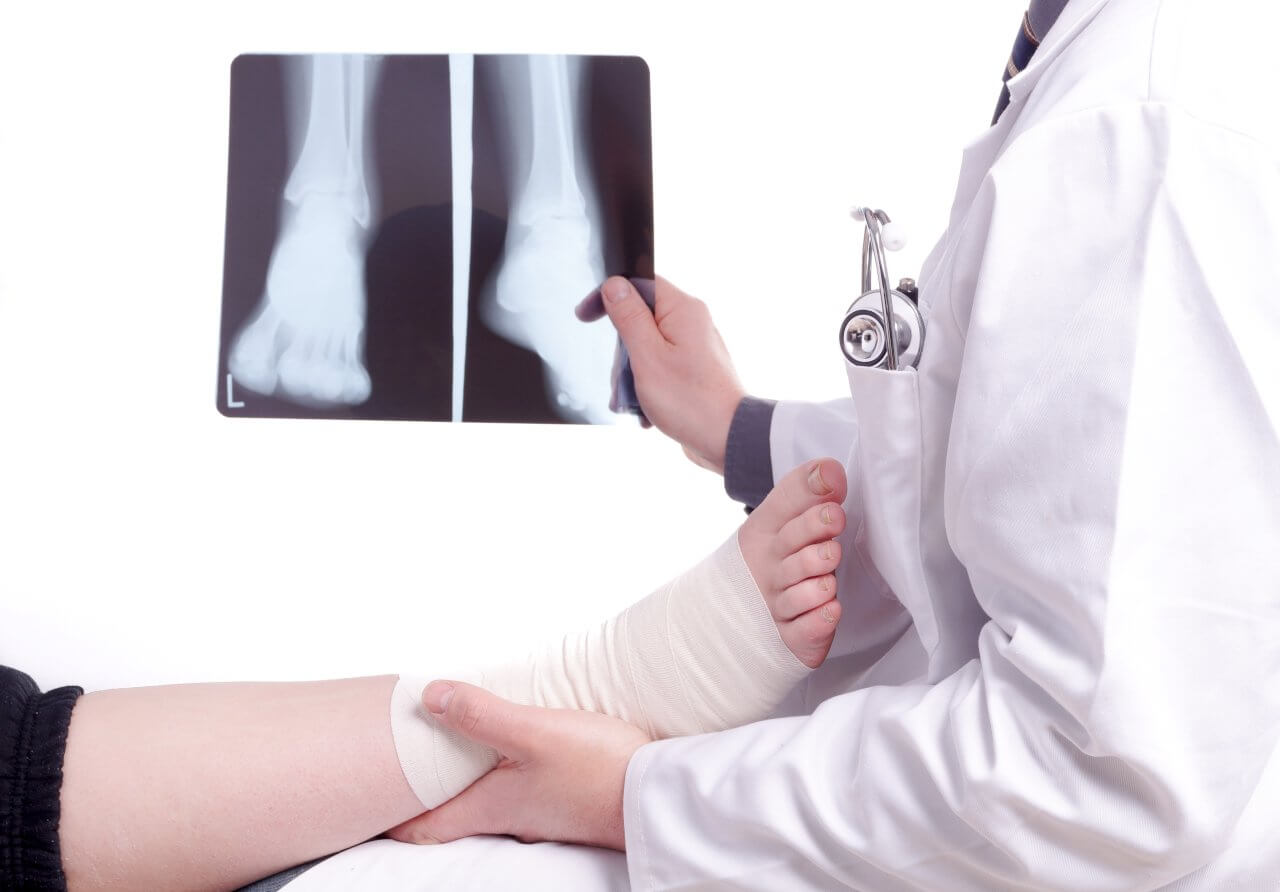
The program includes:
- Initial presentation in the clinic
- clinical history taking
- physical examination
- review of medical records
- laboratory tests:
- complete blood count
- biochemical analysis of blood
- lipid metabolism (HDL/LDL, cholesterol, triglycerides)
- kidney function tests (creatinine, urea)
- coagulation tests (aPTT, PT, INR)
- inflammation indicators (CRP, ESR)
- X-ray examination of the shoulder joint
- CT/MRI scan of the shoulder joint (if indicated, 650/1200 €)
- injections of ACP (3x)
- nursing services
- consultations of related specialists
- treatment by chief physician and leading experts
- explanation of individual treatment plan
- written statement
How program is carried out
During the first visit, the physician conducts a clinical examination and goes through the results of previous diagnostic procedures. After that, you will undergo the necessary additional examinations, such as the laboratory blood and urine tests, X-ray of the shoulder joint, MRI or CT scan. After a comprehensive assessment of the health condition the physician will make sure that you have no contraindications and schedule the therapy.
The first stage of treatment is venous blood sampling. Your physician will draw up to 50 ml of blood from your vein and place it in a special tube. After processing (centrifugation), platelet-rich plasma will be separated and drawn in a syringe. About 3-5 ml of such plasma are required for one procedure.
The next stage of treatment is the introduction of autologous conditioned plasma into the affected joint by intra-articular injection. To distribute the drug in the joint cavity evenly, you will need to rotate your shoulder several times.
Injections are performed with a 3-5 days interval. During this time, you will receive symptomatic therapy and stay under medical supervision. During the final consultation after the last injection, the attending physician will conduct a follow-up examination and give you detailed recommendations for further follow-up and treatment.
Required documents
- Medical records
- X-ray examination, MRI/CT scan (if available)
Service
You may also book:
 BookingHealth Price from:
BookingHealth Price from:
About the department
The Department of Adult and Pediatric Orthopedics, Foot Surgery and Hand Surgery at the Orthopedic Clinic Freiburg provides the full range of medical services in the areas of its specialization. The focus of the team of doctors at the medical facility is on patients with pathologies of large joints, including the knee, hip, shoulder, elbow, ankle, and wrist joints. The department's special offer is autologous cartilage transplantation, which is performed by a very limited number of medical centers in Europe. This innovative surgical technique allows doctors to cure knee, hip, ankle, and shoulder arthrosis. With more than 700 interventions of this kind annually, the department's specialists are deservedly proud of their successful results and professional skills in this field. The department also treats foot and hand diseases, including hallux valgus, hallux rigidus, flat feet, hollow feet, Morton's neuroma, rhizarthrosis, Dupuytren's contracture, trigger fingers, and other pathologies. Surgical interventions for musculoskeletal diseases in adults and children are performed in two high-tech operating rooms that were opened in May 2020. In most cases, the department's doctors manage to perform low-traumatic operations, after which patients recover quickly and leave the hospital as soon as possible. The department performs more than 2,500 interventions annually. The department's team strives to provide patients with top-class medical services in a pleasant and friendly environment. The Head Physician of the department is Prof. Dr. med. Sven Ostermeier.
The priority focus of the department's doctors is autologous cartilage transplantation (the procedure is also called autologous chondrocyte transplantation). The essence of this therapeutic technique is as follows: doctors take a small amount of cartilage tissue, grow the necessary amount of this biological material in the laboratory, and then inject it back into the patient's joint using minimally invasive techniques. The final treatment outcomes can be assessed after 3 months, and after a year, the transplanted cartilage is no different from the patient's own cartilage tissue. The department is a pioneer in the field of autologous cartilage transplantation, so it has tremendous experience in the use of this technique for treating knee, hip, shoulder, and ankle arthrosis. Autologous chondrocyte transplantation is most often indicated for patients with knee arthrosis (gonarthrosis). The treatment technique is a real breakthrough in modern orthopedics since it allows patients to get rid of arthrosis, which causes mobility restrictions and severe pain, without any joint replacement surgery (a surgical procedure to replace the joint with a prosthesis). Autologous cartilage transplantation is not suitable for all patients since it does not give the desired result in the advanced stages of arthrosis. As a rule, ideal candidates for this treatment are patients between the ages of 15 and 55 with intact or partially preserved menisci, without cruciate ligament injuries of the knee, without axial joint disorders, and with a minimum of 2.5 cm2 of cartilage preserved. However, the decision to perform autologous chondrocyte transplantation is made individually, based on the patient's clinical data and general health condition. The department's orthopedists have successfully performed the procedure more than once on patients under the age of 65 who lead an active lifestyle. The key advantages of the method are the restoration of mobility and the elimination of pain, thanks to which patients return to an active lifestyle. In addition, long-term clinical follow-up monitoring of patients after autologous cartilage transplantation confirms the absence of any complications or health problems after surgical treatment.
The department also treats other knee joint diseases, such as meniscus tears, knee ligament tears, patellar dislocation and fracture, dissecting knee osteochondritis, etc. A patellar fracture treatment can be either conservative or surgical, but surgery is usually required. Depending on the severity of the injury, special screws or implants can be placed during the operation, and, in the most complex cases, fragments or even the entire patella have to be removed. A surgical intervention is always followed by a course of rehabilitation aimed at the maximum restoration of the patient's mobility. The department's patients with torn ligaments are also offered conservative and surgical treatment methods. In this case, conservative therapy is most often carried out as a preparation for surgery. As for surgical treatment options, the department's orthopedists successfully perform cruciate ligament plastic surgery, cruciate ligament replacement surgery using the hamstring as an autologous graft, or cruciate ligament suturing. Knee joint operations are almost always performed using low-traumatic surgical techniques that allow patients to recover as soon as possible and return to their normal lives. In addition, when performing knee replacement surgery and other interventions, doctors use the innovative NAVIO navigation system manufactured by the American company Smith & Nephew, which was installed in the operating room in 2020.
The department's specialists treat the full range of hip joint diseases, including arthrosis, intra-articular loose bodies in the hip joint, coxitis, hip impingement, avascular necrosis of the femoral head, and femoral neck fractures. Doctors also treat young patients with hip joint pathologies, the most common of which are Perthes disease and slipped capital femoral epiphysis. The majority of hip joint interventions are arthroscopic manipulations and joint replacement surgery. In addition, the department's specialists successfully deal with articular cartilage repair (for example, in the case of minor cartilage lesions caused by injuries) using the advanced technique of autologous cartilage transplantation or microfracturing. In most cases, hip surgery is performed through a minimally invasive approach using miniature skin incisions or punctures. Patients thus do not experience a severe pain syndrome, blood loss is significantly reduced, and there are practically no surgical risks.
Foot surgery is also an important field of the department's clinical practice. In this area, special attention is paid to the surgical repair of foot deformities, such as hallux valgus, hallux rigidus, hollow foot, clubfoot, flat feet, and hammer and claw toe deformities. The department's doctors also successfully repair foot deformities in children, including flat feet and tarsal coalitions. The department's orthopedists have excellent professional skills in the repair of hallux rigidus (arthrosis of the first metatarsophalangeal joint of the foot). Depending on the severity of the deformity and the patient's general health condition, such surgical techniques as arthrodesis, cheilectomy, hemiprosthesis placement, and CARTIVA partial replacement may be used. For hallux valgus (the formation of a bone "bump" in the area of the big toe) repair, a chevron osteotomy is most often performed. Of particular interest is the treatment of flat feet in children. Conservative therapy is preferred whenever possible, which includes physical exercises (for example, tiptoe standing, circular dynamic exercises for the legs), body weight normalization, wearing orthopedic insoles, etc. In severe cases of flat feet, a surgical intervention may be performed. The department's specialists offer minimally invasive implant surgery, arthrolysis, or the Evans osteotomy for young patients. The optimal type of surgical intervention is determined on an individual basis.
In the field of hand surgery, the department provides patients with effective treatment for finger arthrosis, rhizarthrosis, carpal tunnel syndrome, trigger fingers, and Dupuytren's contracture. In many cases, hand diseases can be treated with conservative methods, but surgery may sometimes be required. Surgical procedures on the hand are performed using microsurgical techniques, which is a great advantage for patients.
The department specializes in the diagnostics and treatment of the following diseases:
- Orthopedics
- Knee diseases in adults
- Knee arthrosis (gonarthrosis)
- Meniscus tears
- Knee ligament tears
- Patellar dislocations
- Patellar fractures
- Osteochondritis dissecans
- Tibial plateau fractures
- Knee bursitis
- Ahlback disease
- Complications of X-shaped and O-shaped lower limb deformities
- Knee diseases in children
- X-shaped and O-shaped lower limb deformities
- Hip diseases in adults
- Hip arthrosis (coxarthrosis)
- Intra-articular loose bodies in the hip joint
- Hip dysplasia in adults
- Hip inflammation (coxitis)
- Hip impingement
- Avascular necrosis of the femoral head
- Hip bursitis
- Lesions of the articular lip of the hip joint
- Hip fractures
- Hip diseases in children
- Perthes disease
- Slipped capital femoral epiphysis
- Shoulder diseases
- Shoulder arthrosis
- Frozen shoulder
- Humeral head fractures
- Shoulder impingement
- Calcific tendonitis of the shoulder
- Distal biceps tendon tears
- Subtotal supraspinatus tendon tears
- Rotator cuff tears
- Shoulder bursitis
- Shoulder dislocation and shoulder instability
- Elbow diseases
- Elbow arthrosis
- Intra-articular loose bodies in the elbow joint
- Elbow dislocation
- Golfer's elbow
- Tennis elbow
- Monteggia fractures
- Radial head fractures
- Distal biceps tendon tears
- Ulnar collateral ligament tears
- Elbow bursitis
- Knee diseases in adults
- Foot surgery
- Foot deformities in adults
- Hallux valgus
- Hallux rigidus
- Hollow foot
- Clubfoot
- Flat feet
- Tailor's bunion or a bunionette
- Tarsal coalition
- Hammer and claw toe deformities
- Foot deformities in children
- Flat feet
- Tarsal coalition
- Ankle arthrosis
- Stress foot fractures
- Compartment syndrome
- Morton's neuroma
- Achillodynia
- Calcaneus fractures
- Heel spur
- Tarsal tunnel syndrome
- Foot deformities in adults
- Hand surgery
- Finger arthrosis
- Rhizarthrosis
- Carpal tunnel syndrome
- Repetitive strain injury
- Dupuytren's contracture
- Tenosynovitis of the hand
- Other pathologies
The department's surgical options include:
- Orthopedics
- Surgical interventions on the knee joint
- Autologous cartilage transplantation, including the Minced Cartilage implantation procedure
- Corrective osteotomy
- Knee arthroscopy
- Partial and total knee replacement surgery
- Cruciate ligament plastic surgery
- Meniscal suturing and removal
- Surgical interventions on the hip joint
- Hip arthroscopy
- Partial and total hip replacement surgery, including implantation of the McMinn prosthesis, hip replacement with minimally invasive ALMIS and AMIS techniques
- Surgery for avascular necrosis of the femoral head
- Surgical interventions on the shoulder joint
- Shoulder arthroscopy
- Rotator cuff suturing for its tears
- Neer endoscopic plastic surgery for shoulder impingement
- Surgical removal of calcifications for calcific tendinitis of the shoulder
- Shoulder replacement surgery
- Surgical interventions on the elbow joint
- Elbow arthroscopy
- Elbow replacement surgery
- Cartilage transplantation
- Elbow stabilization after ligament injuries
- Radial head replacement surgery after elbow fractures
- Surgical interventions on the knee joint
- Foot surgery
- Arthrodesis and cheilectomy for hallux rigidus
- Hemiprosthesis placement and CARTIVA partial replacement surgery for hallux rigidus
- Endoscopic heel spur removal
- Reconstructive surgery for hollow foot repair
- Surgery for flat feet
- Surgery for Morton's neuroma
- Small toe straightening surgery
- Corrective ankle osteotomy
- Ankle arthrodesis
- Ankle arthroscopy
- Surgery for torn ankle ligaments
- Minimally invasive surgery for ankle impingement
- Osteochondral autologous transplantation surgery (OATS) for ankle injuries
- Ankle joint replacement surgery
- Triple arthrodesis on the ankle joint
- Hand surgery
- Neurolysis for carpal tunnel syndrome
- Thumb carpometacarpal replacement surgery to treat rhizarthrosis
- Other methods of surgical treatment
Curriculum vitae
Higher Education and Postgraduate Training
- 1994 - 2000 Medical studies, Hannover Medical School.
- 2002 - 2002 One-year internship, Hannover Medical School.
Additional Qualifications
- Qualifications in cartilage treatment, including in autologous cartilage transplantation.
- Qualifications in chiropractic.
- Qualifications in sports medicine.
- Qualifications in musculoskeletal ultrasound scanning.
- Qualifications in hip ultrasound scanning in children.
- Qualifications in musculoskeletal X-ray scanning.
Medical Practice
- 2002 Assistant Physician, Department of Orthopedics, Hannover Medical School.
- 2002 - 2003 Assistant Physician, Department of Traumatology, St. Bernward Hospital Hildesheim.
- 2003 - 2007 Assistant Physician, Department of Orthopedics, Hannover Medical School.
- 2007 - 2009 Physician, Department of Orthopedics, Hannover Medical School.
- 2009 - 2011 Managing Senior Physician, Department of Knee and Shoulder Surgery, Sports Orthopedics, Orthopedic Hospital Hannover-Annastift MHH.
- Since 2012 Managing Physician, Department of Adult and Pediatric Orthopedics, Foot Surgery and Hand Surgery, Orthopedic Clinic Freiburg.
- Since 2015 Head Physician, Department of Adult and Pediatric Orthopedics, Foot Surgery and Hand Surgery, Orthopedic Clinic Freiburg.
Memberships in Professional Societies
- German Society of Orthopaedics and Traumatic Sports Medicine (GOTS).
- European Society for Sports Traumatology, Knee Surgery and Arthroscopy (ESSKA).
- German Society for Arthroscopy and Joint Surgery (AGA).
- Germany Society for Orthopedics and Orthopedic Surgery (DGOOC).
- German Society for Biomechanics (DGfB).
Peer Review Activities
- Journal of Biomechanics.
- Archives of Orthopaedic and Trauma Surgery.
- Clinical Orthopaedics and Related Research.
- Medical Science Monitor.
- BMC Musculoskeletal Disorders.
- Knee Surgery and Sports Traumatology.
- Journal of Arthroscopic and Related Surgery.
Prizes, Awards, and Honors
- Richard Laskin Prize for Outstanding Research.
- Poster Award, European Society for Sports Traumatology, Knee Surgery and Arthroscopy (ESSKA).
- Poster Award, German Congress of Orthopedic and Trauma Surgery.
Photo of the doctor: (c) Orthopädische Gelenk-Klinik
About hospital
The Orthopedic Clinic Freiburg enjoys the status of a highly specialized medical facility where patients with musculoskeletal diseases are successfully diagnosed and treated. The primary specialization of the medical facility is the provision of comprehensive medical care to patients with joint diseases, such as knee, hip, shoulder, elbow, ankle, and wrist pathologies. The clinic is one of the leading medical centers in Germany and successfully performs autologous cartilage transplantation to treat knee, hip, shoulder, and ankle arthrosis. This treatment method is innovative and is available in only a few clinics in the country. The specialists at the clinic annually perform more than 700 procedures of autologous cartilage transplantation, which is one of the highest rates in the European medical arena. Almost all joint surgeries are performed using minimally invasive techniques. In addition, high-tech navigation systems are widely used at the clinic, which contributes to the high safety of surgical interventions. The clinic's therapeutic options are complemented by surgical treatment of spinal diseases.
In May 2020, a new clinic building with an advanced operating unit covering an area of 2,600 square meters began its work. The unit houses two modern operating rooms with all the necessary equipment. Hygiene and safety standards are strictly met in operating rooms. Imaging diagnostics can be performed directly during the operation whenever required, including X-ray scans, magnetic resonance imaging, digital volume tomography, ultrasound scans, and other examinations. More than 2,500 surgical interventions of varying degrees of complexity are performed at the clinic annually.
The clinic's patients are in the safe hands of highly qualified doctors with long experience in joint surgery. Each patient and their clinical case are unique to the clinic's specialists, so a treatment regimen is developed taking into account the specific clinical indications, needs, and wishes of the patient. The task of the doctors at the clinic is not only to provide patients with high-quality medical care but also to ensure psychological support for patients at all stages of the therapeutic process.
The Orthopedic Clinic Freiburg has been awarded prestigious quality certificates, including the certificate for autologous cartilage transplantation, the endoCert certificate for joint replacement surgery, the D.A.F certificate for foot and ankle surgery, and the DIN ISO 9001:2015 certificate. The number of patients wishing to undergo their treatment at this clinic is steadily growing, which is the main indicator of the success and effectiveness of the medical care provided.
Photo: (с) depositphotos
Accommodation in hospital
Patients rooms
The patients of the Orthopedic Clinic Freiburg live in comfortable single and double rooms. The patient rooms are designed in bright colors and equipped with large windows. Each patient room has an ensuite bathroom with a shower and a toilet. The bathroom has a hair dryer, changeable towels, and toiletries. Standard room furnishings include an automatically adjusting bed, a bedside table, a wardrobe, a flat-screen TV, a DVD player, a telephone, a minibar, and a safe. Wi-Fi is also available in the patient rooms.
Meals and Menus
The patients undergoing their treatment at the clinic are offered three tasty and varied meals a day: breakfast, lunch, and dinner. If, for some reason, you do not eat all the food, you will be offered an individual menu.
Further details
Standard rooms include:
Accompanying person
Your accompanying person may stay with you in your patient room or at the hotel of your choice during the inpatient program.
Hotel
You may stay at the hotel of your choice during the outpatient program. Our managers will support you for selecting the best option.




